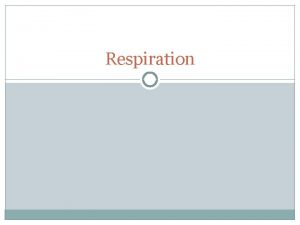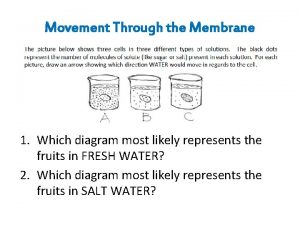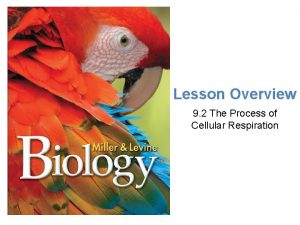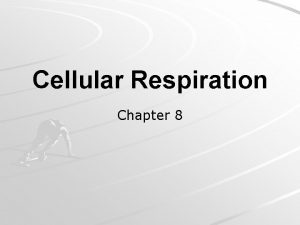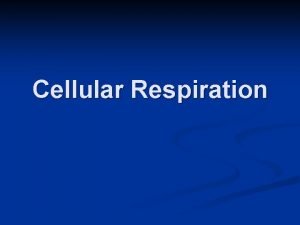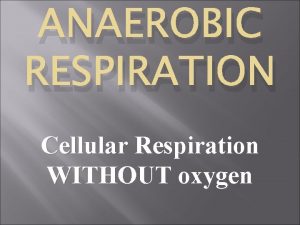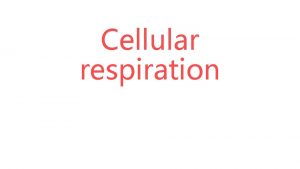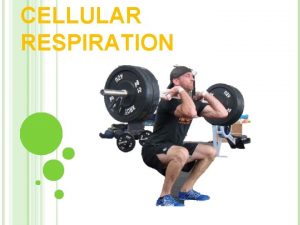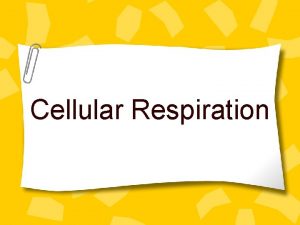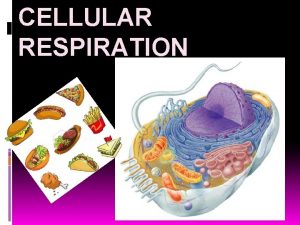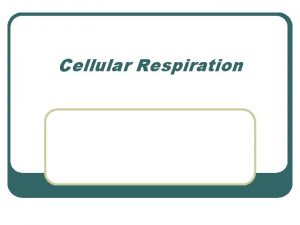Cellular Respiration Chapter 9 1 Cellular Respiration The



















- Slides: 19

Cellular Respiration Chapter 9 -1

Cellular Respiration • The process in which cells make ATP by breaking down organic compounds, like glucose in the presence of oxygen. SUNLIGHT PHOTOSYNTHESIS C 6 H 12 O 6 + 6 O 2 6 CO 2 + 6 H 2 O AEROBIC RESPIRATION

Glycolysis • A biochemical pathway in which glucose is oxidized (loses electrons) to produce pyruvic acid (pyruvate). start (glycolysis) in cytoplasm completed in mitochondrion

Glycolysis - Step #1 • Glucose is split into two, 3 carbon molecules of PGAL. And during this process 2 ATP molecules are used up.

Glycolysis Step #2 • The energy from the 2 PGAL molecules is used to make 4 ADP molecules and 2 molecules of NADH, an energy storing molecule.

Glycolysis Step #3 • 4 molecules of ATP are synthesized from 4 molecules of ADP.

Glycolysis #4 • In this step the phosphates added to make PGAL in step 1 are removed to make 2 molecules of puruvic acid. Even though it appears that 4 ATP molecules were made, there is only a net gain of 2 since 2 are used in step 1.

Products of Glycolysis • Small amounts of ATP • 2 molecules of Pyruvic Acid ATP

Conclusion and Glycolysis Chart • Location – Cytsol just outside the mitochondria • Function – Breaking down glucose to Pyruvic Acid • Reactants – Glucose ADP and NAD (accepts high energy electrons) • Products – ATP, NADH, Pyruvic • Acid.

Fermentation - Cytosol ( without oxygen) Anaerobic Respiration • Process: pyruvic acid (initial reactant )produced from glycolysis is converted to other organic compounds. • Fermentation does not produce ATP but does regenerate NAD+ which keeps glycolysis going.

Pathways of Fermentation • Two main pathways: lactic acid fermentation and alcoholic fermentation

Lactic Acid Fermentation • 1. An enzyme converts pyruvic acid into a 3 -C molecule called lactic acid (stored in your muscles – Soreness) • 2. During fermentation, NADH and H+ lose their hydrogen to pyruvic acid, resulting in NAD+.

Products • Occurs in making yogurt, cheese, and in your muscles.

GLYCOLYSIS C 6 H 12 O 6 2 ATP energy input 2 NAD+ 2 ADP 2 4 NADH ATP energy output 2 pyruvate 2 ATP net LACTATE FORMATION electrons, hydrogen from NADH 2 lactate Fig. 7. 9, p. 118

Alcoholic Fermentation • An enzyme converts pyruvic acid into ethyl alcohol in two steps: – Step -1. A CO 2 molecule is removed from the pyruvic acid, leaving a 2 -C molecule

• Step 2: Two hydrogen atoms from NADH are added to the 2 - carbon compound to form ethyl alcohol, also recycling NAD to return to • Glycolysis.

Products • Process results in the making of beer, wine, and bread.

GLYCOLYSIS C 6 H 12 O 6 2 ATP energy input 2 NAD+ 2 ADP 2 4 NADH ATP 2 pyruvate energy output 2 ATP net ETHANOL FORMATION 2 H 2 O 2 CO 2 2 acetaldehyde electrons, hydrogen from NADH 2 ethanol Fig. 7. 10, p. 119

Conclusion and Alcoholic Fermentation and Lactic acid Chart • • Location – Cytosol Function – Recycle NAD for glycolysis Reactants – Pyruvic Acid and NADH Alcohol Products - – Alcohol, Carbon Dioxide, NAD • Lactic acid Products – Lactic acid and NAD
 Chapter 8 section 3: cellular respiration
Chapter 8 section 3: cellular respiration Cellular respiration harvesting chemical energy
Cellular respiration harvesting chemical energy Explain how amp stimulates cellular respiration
Explain how amp stimulates cellular respiration Chapter 9: cellular respiration: harvesting chemical energy
Chapter 9: cellular respiration: harvesting chemical energy Redox reaction in cellular respiration
Redox reaction in cellular respiration What is the correct equation for cellular respiration?
What is the correct equation for cellular respiration? Chemiosmosis steps
Chemiosmosis steps Types of respiration
Types of respiration Fermentation
Fermentation Why is cellular respiration important
Why is cellular respiration important Complimentary processes
Complimentary processes What's the equation for cellular respiration
What's the equation for cellular respiration Amloplast
Amloplast Formulas for cellular respiration
Formulas for cellular respiration Starting materials for cellular respiration
Starting materials for cellular respiration What happens during glycolysis
What happens during glycolysis Overview of cellular respiration
Overview of cellular respiration Overview of aerobic respiration
Overview of aerobic respiration Overview of cellular respiration
Overview of cellular respiration Cellular respiration
Cellular respiration







